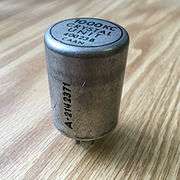Cycle per second

The cycle per second was a once-common English name for the unit of frequency now known as the hertz. The plural form was typically used, often written "cycles per second", "cycles/second", "c.p.s", "c/s", "~" or just "cycles". The term comes from the fact that sound waves have a frequency measurable in their number of vibrations, or cycles, per second.[1]
With the organization of the International System of Units in 1960, the cycle per second was officially replaced by the hertz, or reciprocal second. Symbolically, "cycle per second" units are "cycle/second", while hertz is "1/second" or  .[2] This particular mandate has been so widely adopted as to render the old 'cycle per second' all but extinct.
.[2] This particular mandate has been so widely adopted as to render the old 'cycle per second' all but extinct.
For higher frequencies, kilocycles (kc), as an abbreviation of kilocycles per second were often used on components or devices. Other higher units like megacycle (Mc) and less commonly kilomegacycle (kMc) were used before 1960[3] and in some later documents.[4] These have modern equivalents such as kilohertz (kHz) and megahertz (MHz).
The rate at which aperiodic or stochastic events occur may be expressed in becquerels (as in the case of radioactive decay), not hertz, since although the two are mathematically similar by convention hertz implies regularity where becquerels implies the requirement of a time averaging operation. Thus, 1 Bq is 1 event per second on average whereas 1 hertz is 1 event per second on a regular cycle.
Cycle can also be a unit for measuring usage of reciprocating machines, especially presses, in which cases cycle refers to one complete revolution of the mechanism being measured (i.e. the shaft of a reciprocating engine).
See also
- Cycles per instruction (CPI)
 Crystal resonators, the 1940s-era center unit is marked in kc.
Crystal resonators, the 1940s-era center unit is marked in kc. - Heinrich Hertz
- Instructions per cycle (IPC)
- Instructions per second (IPS)
- MKS system of units a predecessor of the SI set of units
- Normalized frequency
- Radian per second
References
- ↑ Henry Lee Ewbank, Sherman Paxton Lawton, Projects for Radio Speech: A Manual for the Student (1940), p. 151.
- ↑ Taylor, B. N. (2008). International System of Units (SI) (rev. , 2008 Ed. ). DIANE Publishing. p. 27. ISBN 9781437915587.
- ↑ George Grammer (January 1933). "Rationalizing the Autodyne". QST.
The 7000- and 14,000-kc. grid coils are wound with No. 18 enameled wire...
- ↑ Ronald E. Guentzler (April 1967). "The "Monode: Noise Generator". QST.
The Monode described here is usable at frequencies below 144 Mc. with slight modification.